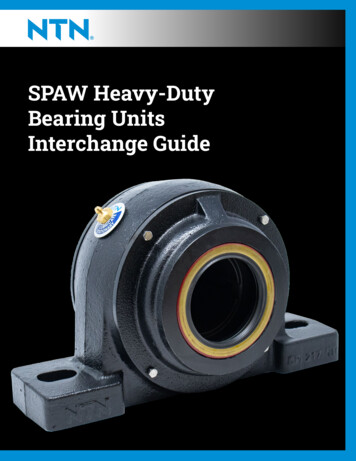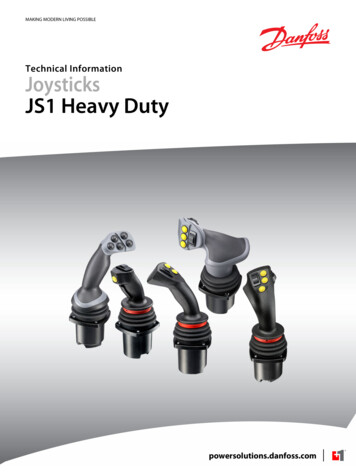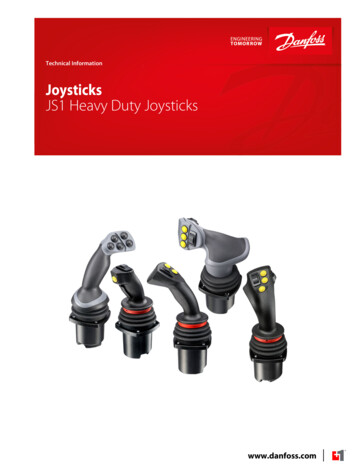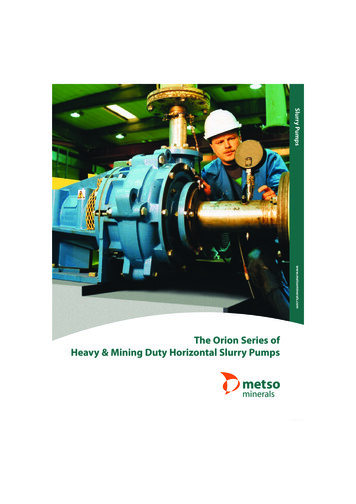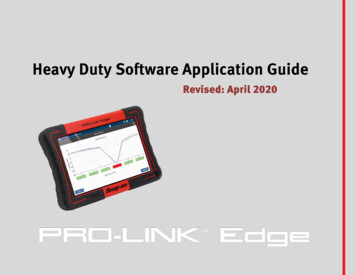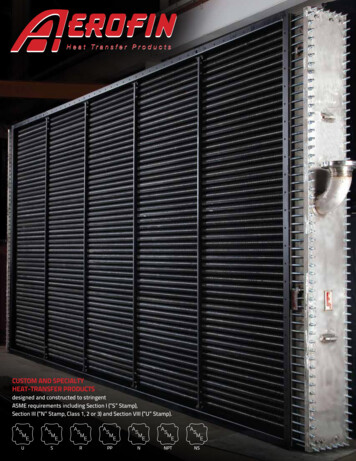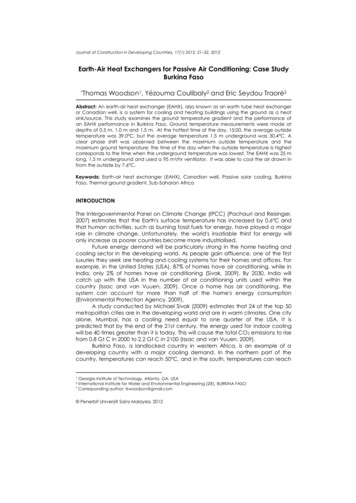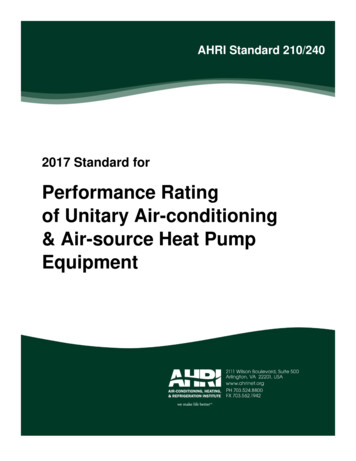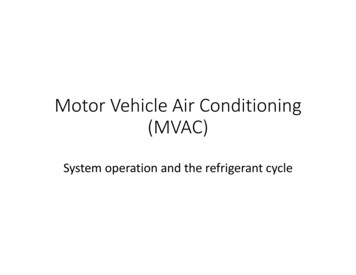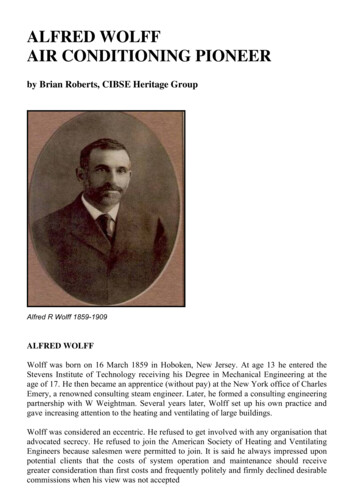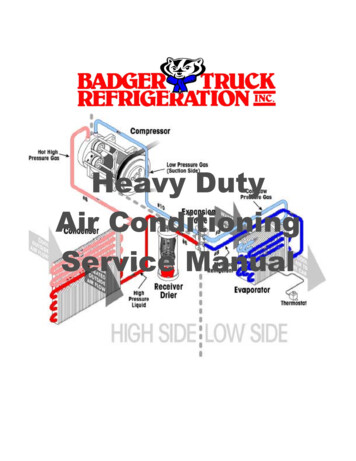
Transcription
Heavy DutyAir ConditioningService Manual
Safety Precautions & WarningsServicing Refrigerant Systems1. Always wear the proper protective eyewear and clothing before working on anyrefrigeration system. Remember, refrigerant in the air conditioning system canreach pressures of over 500 PSI – if one of those lines bursts while you’reworking on the system, it can cause serious injury. If refrigerant gets in your eye,it can freeze your eyeball, causing permanent damage or blindness.2. Always wear work gloves whenever you’re working with condensers orevaporators. The aluminum edges are sharp, and can cause serious cuts.3. Always stay clear of the belts and fan blade, and be careful revving the engine ona car with a flex fan – damaged blades have been known to come flying offwithout a moment’s warning.4. Always use a DOT-approved tank for storing used and recycled refrigerants.Look for the Department of Transportation stamp: DOT 4BW or DOT 4BA.5. Always provide plenty of ventilation when using any electrical testing, recycling orrecovery equipment. Avoid breathing any refrigerant vapor, lubricant vapor ormist. Exposure to these (particularly PAG oil mist) may irritate your eyes, noseand throat.6. Always follow the instructions for your recycling equipment; failure to follow thosedirections could end up causing personal injury or damaging your equipment.Never perform any maintenance or service on your recycling equipment while theunit is plugged in (unless directed to do so) or without first consulting withauthorized service personnel. Removing internal fittings and filters can releasepressurized refrigerant. Use care and always wear appropriate safety wear.7. Never use compressed air to leak test or pressure test an R-134a system or R134a service equipment. Under certain conditions, pressurized mixtures of R134a and air can be combustible. Always follow the proper procedures toprevent any safety hazards. In addition, shop air injects moisture into thesystem, and a pressure surge could damage the evaporator.8. Microprocessors and computers are susceptible to damage from electrostaticdischarge. Always use a static strap when working with these components, andalways take the necessary precautions to prevent damage to electroniccomponents.9. Most A/C service manuals indicate that R-12 turns into deadly phosgene gaswhen burned. Recent studies have shown that, while burning R-12 doesn’tchange it into phosgene gas, it does break down into carbonyl fluoride (COF2),carbonyl chlorofluoride (COCIF) with traces of free chlorine (CI2). And, whilebreathing these byproducts isn’t as deadly as breathing phosgene gas, it still canbe very harmful. In large enough concentrations, these byproducts can displaceenough oxygen to cause asphyxiation.10. To prevent cross contamination between refrigerants, verify that the A/C systemhas the correct label and unique service fittings designed for the refrigerant beingused. If you’re ever in doubt, check the system with a refrigerant identifier.
THEORY OF OPERATIONChapter 1Table of ContentsTheory of Operation:Heat TransferChange of StateLatent HeatBoiling Temperature/Pressure RelationshipR12 vs R134aRefrigerant Boiling Point/Pressure RelationshipBasic Air Conditioning System1-1
THEORY OF OPERATIONHeat TransferHow does an air conditioner make the air feel cooler?To understand how an air conditioner works, first we have to look at some of thephysical principles involved. Let’s begin with heat and heat transfer:Everything you see, touch, taste, smell or hear has a certain amount of heat. Heat isenergy, and everything you’ll run into has some heat. The only exception is at absolutezero, or -460o F. Since you aren’t likely to run into anything quite that cold, let’s assumethat every object has a certain amount of heat.When talking about heat transfer, there really isn’t any such thing as “cold” – sure, an icecube may feel cold to the touch, but actually it just has less heat than your hand that’swhy it feels cold. It’s hard to think of an ice cube having heat, but that’s actually thecase.Now, just for a minute or so, hold the ice cube in your hand. What happens? To beginwith, the ice cube begins to melt. Another thing you’ll notice is your hand gets colder.And wetter. What does all that tell us?That tells us the heat is transferring from your hand to the ice cube. This examplemakes it obvious because the greater the difference in temperature, the faster the heattransfer.1-2
THEORY OF OPERATIONHeat always flows to cold until the temperatures equalBasically, the Second Law of Thermodynamics says: Heat will always flow from awarmer object to a cooler one, until the temperatures become equal.When you held the ice cube in your hand,the heat from your hand began to traveltoward the ice cube. The ice cubeabsorbed heat, causing it to melt. As theheat traveled from your hand, your handbecame colder; slowly, the temperature ofthe ice cube and your hand were trying toequalize. If the ice cube was large enough,and could absorb enough heat, eventuallyyour hand and the ice cube would reach thesame temperature.This drawing shows how heat moves; one ofnature’s laws. Heat always moves from a warm toa cool area – heat flows into the cab in hotweather and flows out in cold weather.That’s the principle behind how an airconditioner cools the air in your machine:by flowing warm air over a coldevaporator, the heat from the air flows tothe cold evaporator, making the air lesshot. The heat from the air flows into theevaporator fins, and from there into thecold refrigerant. The refrigerant carriesthe heat away from the evaporator,cooling the evaporator so it can cool moreair.The evaporator absorbs heat while the condenserreleases heat.1-3
THEORY OF OPERATIONThis picture shows the direction of refrigerant and engine coolant flow in the system.The air conditioner evaporator coil and condenser, and the heater core, are the mainpoints of heat transfer.1-4
THEORY OF OPERATIONChange of StateHeat transfer can force matter to change its stateAll matter exists in three states: solid, liquid andgas. That’s an important point to remember whenlooking at how an air conditioner works.Remember what happened to your hand whenyou held onto the ice cube? Your hand becamecolder, but it also became wetter – the transfer ofheat caused the ice cube to change its state froma solid to a liquid that is, from ice to water.That’s one change that heat transfer can cause, butthere’s another change that we’re going to beconcerned with: the change in state when water goesfrom liquid to gas.By applying enough heat, we can force an object tochange its state, from a solid to a liquid to a gas.The same is true in reverse: by removing enoughheat, we can force an object to change states from agas to a liquid to a solid.You’re familiar with that change: if you continue toapply heat to water, eventually it begins to boil andturn to steam. But there’s more going on thanmeets the eye.Latent HeatIt takes more heat to change water to steam than to boil waterTo understand the heat necessary to force water to change states, we need to be able tomeasure the heat that water absorbs. Fortunately, someone already defined that for us.A British Thermal Unit, or BTU, is the amount of heat necessary to raise one pound ofwater one degree on the Fahrenheit scale at sea level. In other words, to increase thetemperature of one pound of water from 100oF to 212oF (38oC to 100oC), you have toapply 112 BTUs of heat to the water. This is called “Sensible Heat” – as you apply heat,the temperature increases. But that still isn’t enough heat to change that pound of waterfrom a liquid to a gas. You’d have to apply an additional 970 BTUs of heat to changethat pound of water into a pound of steam.1-5
THEORY OF OPERATIONoHeat needed to convert one pound zero degree ice to one pound 212 degree steamThe point to remember here is even though you added 970 BTUs to the water, the watertemperature never went over 212oF (100oC). That 970 BTUs was the energy necessaryto change the state of the water from a liquid to a gas (vapor). The extra heat beingabsorbed is known as “The Latent Heat of Evaporation,” or Latent Heat.What about changing back from a vapor to a liquid? The principle’s the same, but theheat flows in the opposite direction. For steam to change states back to a liquid, it mustrelease 970 BTUs of heat. At this point, as long as the liquid doesn’t release any moreheat, the water will still be 212oF (100oC). The transfer of 970 BTUs simply allowed thewater to condense back from a gas (vapor) to a liquid. This is “The Latent Heat ofCondensation.”The Merriam-Webster Dictionary defines latent as: “Present, but not visible or active.”The additional heat required for water to change states is present, but since the watertemperature doesn’t change, we say the heat is latent.What all that means is a substance can absorb or release a lot of heat, without actuallychanging temperature itself, while changing states from a liquid to a gas, or from a gasto a liquid. As you’ll soon see, these principles explain how the refrigerant in an airconditioning system can absorb and carry off heat.But before we dive into the operation of a basic air conditioning system, there’s onemore set of rules we need to examine: the rules that define the relationship betweenpressure and boiling temperature.1-6
THEORY OF OPERATIONBoiling Temperature/Pressure RelationshipBoiling temperature directly affected by pressure changesUntil now we’ve made a lot of blanketstatements about the boiling temperatureof water. We said it boils at 212oF, or100oC. That’s true but only at sea level.If you set up camp at the top of amountain, say, 5000 feet elevations, you’dfind that water boils at a lowertemperature. That’s because atmosphericpressure’s lower at 5000 feet than it is atsea level.The converse is also true: If you set upcamp in Death Valley, you’d find waterboils at a higher temperature than 212oF (100oC).Death Valley is below sea level, so atmosphericpressure’s higher than at sea level.Now, granted, the temperature difference we’retalking about isn’t very much – maybe a coupledegrees no more. Butthe pressure differencesaren’t all that great either.You’re only talking abouta couple of poundsdifference in atmosphericpressure between DeathValley and Mount St.Helens.The pressure radiator cap seals the cooling system at theinlet on top of the radiator. Caps are pressure rated tomatch cooling system design. Each pound of pressure onthe cooling system raises the boiling point of coolant threedegrees Fahrenheit, so the pressure cap extends thecooling system operating range above the normal boilingpoint. The cap pressure valve opens when operatingpressures are high. Coolant can flow through the heatercore regardless of thermostat position.But inside an airconditioning system we’llbe working with pressuredifferences ranging froma high of 350 PSI (2400kPa), down to as little as30” vacuum. At 30”vacuum, water boils atless than -100F (-23oC)!So far we’ve looked atthe principles of heattransfer as they apply to water, but these principlesremain the same for all condensable fluids. To workin an air conditioning system, we need a fluid withboiling temperatures and pressures that are moremanageable than water’s.ooWater doesn’t necessarily boil at 212 F, or 100 C pressure affects boiling temperature. By increasingsystem pressure, boiling temperature increases.1-7
THEORY OF OPERATIONRefrigerant Boiling Point/Pressure RelationshipPressure changes affect the refrigerant temperature and boiling point That’s how an air conditioning systemworks: The low side of the systemmaintains a fairly constant pressuredesigned to keep the evaporatortemperature at about 32oF (0oC). Since therefrigerant is at its boiling temperature, itshould take on heat and boil, changing stateinto a vapor.On the system’s high side, the processreverses – pressures rise well over 100 PSI(690 kPa), increasing the refrigerant’stemperature and its boiling point. In fact, atthese pressures, the refrigerant temperaturewould be higher than outside air – the refrigerantwould like to change back into a liquid.Latent heat is the heat required to make aliquid at a certain pressure turn into a vapor atthat pressure. The saturation temperaturechanges with the pressure of the refrigerant.But it can’t. Not yet, anyway – not until it gets ridof the heat it absorbed earlier when it changed states to become a vapor. Until it gets ridof that additional heat, it will remain a vapor. The additional heat keeping the refrigerantfrom changing back into a liquid is called “superheat.” To condenser back into a liquid, ithas to release that superheat.That’s easy – remember, when the refrigerant pressure increased, so did its temperature– well above the ambient air temperature. The “superheated” refrigerant passes throughthe condenser and has no problem releasing its heat to the outside air, enabling it tocondense back into a liquid.These principles of temperature, pressure, boiling point and heat transfer are what allowan air conditioning system to work.1-8
THEORY OF OPERATION
New RefrigerantHFO 1234 fHFO-1234yf HFO-1234yfHFO 1234yf Systemoperating pressures are similar to anR134a system It is mildly flammableWork area must have pproperp ventilation Handling and storage of cylinders must meetOSHA requirements HighHi henergy requiredi d forf ignitioni itiVery few vehicle sources will ignite refrigerant Open flame will ignite
New RefrigerantHFO 1234 fHFO-1234yf NewService Equipment [J2843 – J2851] New Technician Certification HFO-1234yf[J2845] Safety IssuesR fiRefrigerantthhandlingdli OSHARequirementsWorkspace Handling and storage of containers ProperService Procedures
New RefrigerantHFO-1234yf StateUse Regulations Flammability Systemrefrigerantcontamination issues Effectsare unknown when mixingR-134a and other SNAP listedrefrigerantsgwith HFO-1234yfy p
Air Conditioning Service Manual . Safety Precautions & Warnings Servicing Refrigerant Systems 1. Always wear the proper protective eyewear and clothing before working on any refrigeration system. Remember, refrigerant in the air conditioning system can reach pressures of over 500 PSI – if one of those lines bursts while you’re working on the system, it can cause serious injury. If .
